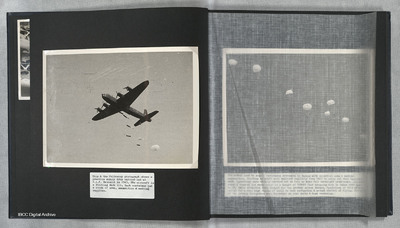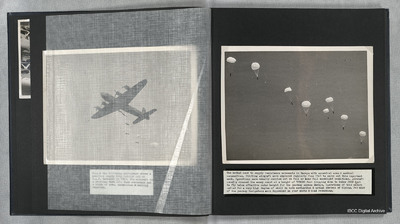Stirling parachute supply drop
Title
Stirling parachute supply drop
Description
Photo 1 is a Stirling dropping supplies containing arms, ammunition and medical supplies.
Photo 2 is the supplies on parachutes.
Photo 2 is the supplies on parachutes.
Date
1943
Temporal Coverage
Language
Type
Format
Two b/w photographs on an album page
Publisher
Rights
This content is available under a CC BY-NC 4.0 International license (Creative Commons Attribution-NonCommercial 4.0). It has been published ‘as is’ and may contain inaccuracies or culturally inappropriate references that do not necessarily reflect the official policy or position of the University of Lincoln or the International Bomber Command Centre. For more information, visit https://creativecommons.org/licenses/by-nc/4.0/ and https://ibccdigitalarchive.lincoln.ac.uk/omeka/legal.
Identifier
PThomasAF20040007,
PThomasAF20040008
PThomasAF20040008
Transcription
[Photograph]
This & the following photograph shows a practice supply drop carried out at R.A.F. Methwold in 1943. The aircraft is a Stirling Mark III. Each container had a stock of arms, ammunition & medical supplies.
[Page break]
[Photograph]
The method used to supply resistance movements in Europe with essential arms & medical necessities. Stirling aircraft were employed regularly from 1943 to carry out this important work. Operations were usually carried out in full or near full moonlight conditions. Aircraft usually crossed the enemy coast at a height of 7/8000 feet dropping down to below 2000 feet to fly below effective radar height for the journey across Europe. Operations of this nature called for a very high degree of skill in both navigation & actual control of flying. For most of the journey Navigators were dependant on star shots & dead reckoning.
This & the following photograph shows a practice supply drop carried out at R.A.F. Methwold in 1943. The aircraft is a Stirling Mark III. Each container had a stock of arms, ammunition & medical supplies.
[Page break]
[Photograph]
The method used to supply resistance movements in Europe with essential arms & medical necessities. Stirling aircraft were employed regularly from 1943 to carry out this important work. Operations were usually carried out in full or near full moonlight conditions. Aircraft usually crossed the enemy coast at a height of 7/8000 feet dropping down to below 2000 feet to fly below effective radar height for the journey across Europe. Operations of this nature called for a very high degree of skill in both navigation & actual control of flying. For most of the journey Navigators were dependant on star shots & dead reckoning.
Collection
Citation
“Stirling parachute supply drop,” IBCC Digital Archive, accessed April 18, 2024, https://ibccdigitalarchive.lincoln.ac.uk/omeka/collections/document/22998.
Item Relations
This item has no relations.


